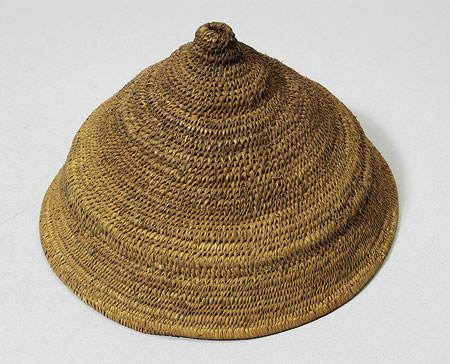Accession Number:
1936.10.67
Country:
Sudan
Region:
[Southern Sudan]
Cultural Group:
Anywaa [Anuak]
Date Made:
By 1936
Materials:
Plant Fibre
Process:
Basketry , Coiled
Dimensions:
Ht = 105, L base = 175, W base = 170, th walls = 3.5, W strips = 1 mm, diam hole at apex = 8 mm [RTS 11/1/2005].
Weight:
77.7 g
Local Name:
aduda
Other Owners:
Presumably collected by Evans-Pritchard during his period of fieldwork amongst the Anuak between early March and May 1935 [RTS 18/6/2004].
Field Collector:
Edward Evan Evans-Pritchard
PRM Source:
Edward Evan Evans-Pritchard
Acquired:
Donated 1936
Collected Date:
March - May 1935
Description:
Basketwork cap with a conical body, open at the apex.
This has been made using a coiling technique, from a frame built up of thin lengths of flexible plant fibre or twig, bent into a spiral and joined to adjacent coils by narrow strips of yellowish brown plant fibre wrapped around the core and woven in with the neighbouring rows (Pantone 729C).
The lower edge has been neatly finished off with a similar strip, more tightly bound.
The surface of the cap is slightly ridged, and its sides rise to a distinctive knob at the top.
It is complete and intact, with a weight of 77.7 grams.
The cap is 105 mm high, and measures 175 by 170 mm across the lower edge; the walls are 3.5 mm thick, and the fibre strips around 1 mm wide, while the hole through the top has a diameter of 8 mm.
Collected by E.E. Evans-Pritchard during his fieldwork amongst the Anuak, which took place between early March and May 1935 (E.E. Evans-Pritchard, 1940, The Political System of the Anuak of the Anglo-Egyptian Sudan, p. 3).
This type of cap is called aduda, and is worn by high ranking girls at their marriage ceremonies. Evans-Pritchard describes the ceremony: “when the daughter of a noble marries … [the bride comes] wearing around her neck a string of dimui beads and bearing in her hand a dem spear. She is draped around the waist with a leopard’s skin and wears on her head a cap decorated with beads ( aduda ). The skin and the cap become the property of the bridegroom.” (E.E. Evans-Pritchard, 1940, The Political System of the Anuak, p. 113). After the ceremony, the beads are supposedly removed. However on this example, there are no traces of the stitching that might have been used to attach beads, such as seen on 1936.10.66 (a larger version of the same type of cap but with its beads in place), and unlike that example, this cap has no traces of residual ochre on the interior surface. These things suggest that rather than being a cap from a marriage ceremony, this actual example had never been used, and may have been either commissioned specifically for Evans-Pritchard, or perhaps bought directly from the craftsman.
Rachael Sparks 25/9/2005.
Collected by E.E. Evans-Pritchard during his fieldwork amongst the Anuak, which took place between early March and May 1935 (E.E. Evans-Pritchard, 1940, The Political System of the Anuak of the Anglo-Egyptian Sudan, p. 3).
This type of cap is called aduda, and is worn by high ranking girls at their marriage ceremonies. Evans-Pritchard describes the ceremony: “when the daughter of a noble marries … [the bride comes] wearing around her neck a string of dimui beads and bearing in her hand a dem spear. She is draped around the waist with a leopard’s skin and wears on her head a cap decorated with beads ( aduda ). The skin and the cap become the property of the bridegroom.” (E.E. Evans-Pritchard, 1940, The Political System of the Anuak, p. 113). After the ceremony, the beads are supposedly removed. However on this example, there are no traces of the stitching that might have been used to attach beads, such as seen on 1936.10.66 (a larger version of the same type of cap but with its beads in place), and unlike that example, this cap has no traces of residual ochre on the interior surface. These things suggest that rather than being a cap from a marriage ceremony, this actual example had never been used, and may have been either commissioned specifically for Evans-Pritchard, or perhaps bought directly from the craftsman.
Rachael Sparks 25/9/2005.
Primary Documentation:
Accession Book Entry
[p.
410] - 1936 [insert] 10 [end insert] E.
EVANS-PRITCHARD, M.A., Exeter College, Oxford.
- Specimens collected by himself in the EASTERN SUDAN, while travelling with a Grant from the
Rockefeller
Leverhulme Trustees, viz: [p.
416] [insert] 67 [end insert] -
Aduda
, similar [conical basket-work] cap, from which the beads have been removed after the marriage ceremony.
ANUAK.
Card Catalogue Entry - There is no further information on the catalogue card [RTS 30/1/2004].
Old Pitt Rivers Museum label - Adudä , hat worn by girls of high rank. The beads have been removed after the marriage ceremony. ANUAK, E. SUDAN, d.d. E. Evans-Pritchard, 1936 [obverse] 1936.10.66 1936.10.67 [reverse; rectangular metal-edged tag, tied to object; RTS 11/1/2005].
Card Catalogue Entry - There is no further information on the catalogue card [RTS 30/1/2004].
Old Pitt Rivers Museum label - Adudä , hat worn by girls of high rank. The beads have been removed after the marriage ceremony. ANUAK, E. SUDAN, d.d. E. Evans-Pritchard, 1936 [obverse] 1936.10.66 1936.10.67 [reverse; rectangular metal-edged tag, tied to object; RTS 11/1/2005].




